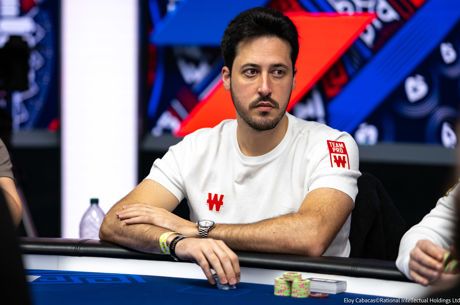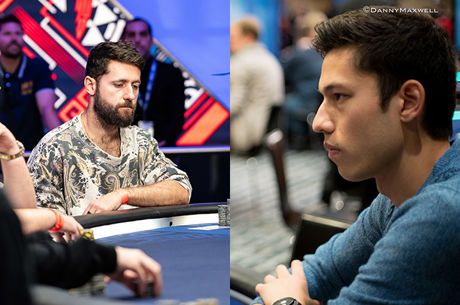Teachable Moments From Twitch: Hero Calling vs. Bluff Catching

I'm back with another tidbit of poker knowledge to share from poker pro Ryan Laplante's Twitch stream. For 11 days at the end of September, Laplante played and gave in-depth explanations for every significant line he took in daily streams shown on his Twitch channel. If you missed it, there is still time to watch the videos while they last.
I want to highlight one hand in particular Laplante played during a $215 buy-in six-handed no-limit hold'em tournament that I found extremely interesting. It was early in the tournament and the blinds were 30/60. With the under-the-gun player sitting out the cutoff limped, then an aggressive player raised to 200 from the button. The action folded to Laplante who had been dealt K♠10♥ in the big blind, and with the effective stacks about 8,000 he called the raise as did the limper.
The flop came 10♣3♣3♦ and after it checked to the raiser who continued with a bet, Laplante decided to check-raise. I found this a little unusual, but things really got spicy when (after the cutoff folded) the villain on the button three-bet the flop and Laplante called.
The 4♠ fell on the turn and Laplante check-called a half-pot bet from the villain. The river then brought the A♠ and both players checked, and the pot ended up being chopped when villain showed Q♠10♠. Laplante gave his thoughts on the hand.
"Here's a general rule of thumb," he began. "If your opponent can bet with a worse hand than yours for value, you should rarely fold. This is true unless they do not have many value combos and they are almost never bluffing, but if they can do it with many worse hands for value and they could have some bluffs as well, then you should never fold."
At first glance, I thought Laplante was bluff catching when he called the flop three-bet with K♠10♥. This is a break-even proposition at best because you don't expect to be ahead of value hands and are just hoping that villain is bluffing often enough to justify your call.
However, Laplante's explanation cleared up my confusion as to why he took this line. He wasn't bluff catching. It was more of a hero call because he expected to beat many of villain's value combos.
In the games I play, very few opponents would ever take the line this villain did for value with hands worse than K-T, and most of them would not do it as a bluff very often either. In my experience, this is usually J-J at worse or a few really strong flush draws like A♣K♣.
This would make calling with K-T here an ill-advised bluff catch. In my games, and probably in yours, the hand should be folded to this much action on the flop. Here though, there are a few reasons why the play is a hero call that makes sense in Laplante's game.
Remember, this is a high stakes online 6-max tournament with a player sitting out and a recreational player limping in the cutoff. In such an environment, fireworks should be expected. Combine this with the fact that both the villain and Laplante are aggressive players, and you have a recipe for some above-the-rim action.
Laplante knew that villain would try to isolate the limper with a wide range of hands. This means that he would be vulnerable to some check-raise bluffs postflop, especially on a board like 10♣3♣3♦ where we have more hands containing a 3 in our big blind defending range and our hand also blocks some of the K-K, T-T, and A-T combos in our opponent's continuation betting range.
Laplante often check-raise bluffs in spots like this with backdoor drawing hands such as 5♦4♦, 9♦8♦, J♣9♠, and the like. That's a lot of combos, so he needs to do so for value with a wide range as well. Choosing K-T as a hand with which to do so makes sense in light of this.
From villain's perspective, Q♠10♠ is a clear iso-raise and c-bet, but I am not sure why he chose to three-bet it on the flop. It's true that Laplante is often bluffing, but three-betting may cause him to fold many of those bluffs as well as any hands worse than Q-T that Laplante may have check-raised for value.
It seems ambitious to me, but maybe this villain knows something I don't. My best guess is that he felt he was ahead but that his hand needed some protection (?). Maybe he would just call down with less vulnerable hands like 3-3, T-T, K-K, or A-A. If this is the case, then hero calling with K-T is even more profitable since the strongest value hands are not in villain's flop three-betting range.
The fact that Laplante called the flop three-bet and turn barrel shows that he expected villain to have hands like Q-T-offsuit and some bluffs in his range. If he only had Q-T-suited, then that would make only 2 value combos we beat. In that case, he would need a lot of bluffs. If he has Q-T-offsuit as well, then we beat 8 combos and he doesn't need to be bluffing as often to make hero calling with K-T profitable.
The aggressive nature of this specific, late position 6-max scenario and of the two players involved led to an opportunity for frequent bluffing, thin value betting, and ambitious hero calling that most of us just don't get to see in the games we play. We should not implement a play like this under more passive game conditions, but it serves as a good example of what we can expect to see when we move up to more cutthroat games.










